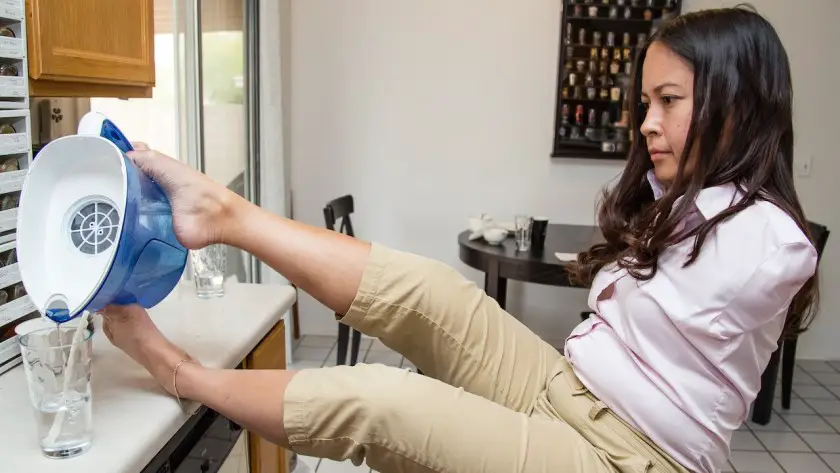Communication is an essential tool that humans thrive on.
We cannot underplay the importance of effective communication in any way.
A person’s inability to hear should not hinder the transmission of information. There are diverse formal and informal forms of proper communication for persons living with disabilities.
The use of sign language is the primary and most popular form of communication for deaf persons.
However, for a deaf person without hands, the mere use of sign language as a means of communication could be limiting.
There are recommendations and other means to consider while communicating with a deaf person without hands.
Keep reading to know more.
Table of Contents
- Basic Etiquettes for Communicating with a Deaf Person without Hands
- 5 Tips to Remember When Communicating With a Deaf Person without Hands
- How a Deaf Person without Hands Can Communicate
- Assistive Technology for the Deaf
- Types of Assistive Technology
Basic Etiquettes for Communicating with a Deaf Person without Hands
1. Be attentive
Listen to what the other person has to say. Communication is a two-way dynamic.
You cannot be the only one speaking; give space for the deaf person to share their thoughts. Make sure you give enough room to listen patiently to what the other person says.
Related: 7 Amazing Ways to Get the Attention of a Deaf Person
2. Maintain eye contact
Pay rapt attention by maintaining eye contact with the deaf person. Breaking eye contact in the deaf community can be likened to being rude intentionally.
To avoid this, ensure you always face the deaf person and never break eye contact while communicating.
3. Establish the general topic of your conversation
Once the basis of a conversation has been established, it is easier for deaf people to communicate with you.
Don’t change the topic abruptly, as it might be challenging for them to follow the conversation. Signal a change and pause regularly to confirm that they are in sync with you.
4. Explain disruptions
In the case of disruptions or interruptions, make sure you explain to the deaf person. It might seem impolite of you to leave in the middle of the conversation.
5. Offer a summary at the end of your conversation
It will be kind of you to offer to summarize all you both discussed.
Remember to ask before doing this, as it might be unnecessary for some deaf people yet helpful for others.
Related: 10 Ways to communicate with a Deaf Person without Sign Language
5 Tips to Remember When Communicating With a Deaf Person without Hands

Keep the following recommendations in mind while communicating with a deaf person.
1. Get their attention before communicating
Deaf people process information visually; hence, you must get their attention before communicating.
You can achieve this by waving your hand or tapping them slightly on the shoulder. Never scream or yell.
2. Ensure that there is proper lighting and no background noises
The deaf person might not understand you if they cannot see your face. To prevent this, make sure you are visible by avoiding being in front of a bright light source.
Also, eliminate background noises as much as you can.
3. Keep trying to communicate with the deaf person
It might not be easy to communicate with a deaf person, but you need to keep trying. Don’t give up.
4. Be clear and direct during communication
Assimilation is crucial in the communication process. Make sure you are as straightforward as possible while speaking with a deaf person.
Depending on your medium of communication, keep your sentences short. Also, avoid being in a rush.
5. Don’t place anything in your mouth while talking
This tip is mandatory for cued speech and lip-reading techniques. It would be best if you aimed to be as straightforward as possible.
Related: How to Take a Deaf Person’s Order
How a Deaf Person without Hands Can Communicate

1. Other sign languages
Some sign languages such as the Yolngu Sign Language (Australia) and the Central Taurus Sign Language of Turkey involve using feet.
A deaf person without hands can use these sign languages that require the feet.
The combination of body parts such as the shoulder, feet, and nose can also be used distinctively by deaf individuals without hands.
2. Cued Speech
Cued speech is a visual code used in the transmission of spoken language.
It doesn’t require the use of speech or hearing.
All the user needs to do is to show the mouth movements that conform to the cues. Through the use of vision, users who are deaf have access to the fundamental properties of spoken language.
A person communicating with a deaf person uses distinct hand shapes or hand gestures in any location near the mouth.
The handshapes represent consonant phonemes while signs near the mouth represent vowels. These cues will enable the deaf person to see what is said and correctly communicate.
The deaf person will also be able to distinguish similar sounds through cues.
3. Speech Reading
Also called lip-reading, speech reading is an excellent form of visual communication, especially for deaf people without hands.
The deaf person needs to face the speaker to monitor the spoken words closely to gain clarity.
4. Body Language and Gestures
Another visual mode of communication is the use of body language and gestures. Communicating with a deaf person without hands requires prompt attention to body features and expressions.
A deaf person can read one’s tone from the expressions and body language.
For example, a happy person might appear relaxed and probably smile. On the other hand, an angry or sad person might show signs of withdrawal or tension.
5. Use of an Interpreter
A specialist who provides interpretation, translation and other communication services used by individuals who are deaf is referred to as a deaf interpreter.
A deaf interpreter who can work as a hearing interpreter or function in both roles is a deaf-hearing interpreter.
The essence of this person is to make sure that adequate information is passed across to the deaf person in a manner that they understand. Using such a skilled interpreter, a deaf person without hands can communicate with others effectively.
Assistive Technology for the Deaf
Assistive Technology includes technological devices made specially to assist the deaf and those hard of hearing.
Some devices are hearing aids, alerting devices, video relay services, tactile devices, and many more.
These devices provide amplified sounds and substitute ways to get information through vibration and vision.
Types of Assistive Technology
1. Hearing Technology
These could be assistive listening devices or personal amplification devices.
Assistive listening devices can be used by individuals or a large group of people, while personal amplification devices are specifically for individuals.
A deaf person without hands can make use of hearing aids easily as they are the most common hearing technology devices. The design of hearing aids amplifies sounds for the hearer by making speech more intelligible.
Hearing aids also correct impaired hearing in deaf people.
2. Communication Support Hearing
These are used for communication purposes by deaf individuals.
Examples of such technologies are the voice carryover telephone and video relay services.




